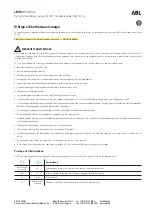
WARNING
79)
The pretensioner may be used only
once. Contact a Jeep Dealership to have it
replaced after it has been deployed.
80)
Removing or otherwise tampering with
seat belt and pretensioner components
is strictly prohibited. Any operations on
these components must be performed by
qualified and authorised technicians.
Always contact a Jeep Dealership.
81)
For maximum safety, keep the back of
your seat upright, lean back into it and
make sure the seat belt fits closely across
your torso and pelvis. Always fasten the
seat belts for both the front and rear seats!
Travelling without wearing seat belts will
increase the risk of serious injury and even
death in the event of an accident.
82)
If the belt has been subjected to high
levels of stress, for example after an
accident, it should be changed completely
together with the attachments, attachment
fixing screws and the pretensioner. In
fact, even if the belt has no visible defects,
it may have lost its resilience.
WARNING
33)
Operations which lead to impacts,
vibrations or localised heating (over 100°C
for a maximum of six hours) in the area
around the pretensioner may damage or
deploy it. Contact a Jeep Dealership
should intervention be necessary on these
components.
CHILD PROTECTION
SYSTEMS
CARRYING CHILDREN
SAFELY
83) 84) 85) 86)
For optimal protection in the event of an
impact, all occupants must be seated
and wearing adequate restraint
systems, including newborn and other
children! This prescription is
compulsory in all EC countries
according to EC Directive 2003/20/EC.
Children below the height of 1.50
metres and until 12 years, must be
protected with suitable restraint
systems and be seated on the rear
seats.
Statistics on accidents indicate that the
rear seats give a better performance
when protecting children safety.
Compared with an adult, a child's head
is larger and heavier in proportion to
their body and the child's muscular and
bone structures are not fully developed.
Therefore, correct restraint systems
other than adult seat belts are
necessary to reduce as much as
possible the risk of injuries in the event
of an accident, braking or sudden
manoeuvre.
Children must be seated safely and
comfortably. Depending on the
characteristics of the child restraint
systems used, you are advised to keep
children in rearward facing child
restraint systems for as long as
possible (at least until 3–4 years old),
since this is the most protected position
in the event of an impact.
The choice of the most suitable child
restraint device depends on the weight
and size of the child. There are various
types of child restraint systems, which
can be secured to the vehicle by means
of the seat belts or with the ISOFIX/i-
Size anchorages.
It is recommended to always choose
the restraint system most suitable
for the child; for this reason always refer
to the Owner Handbook provided with
the child restraint system, to be sure
that it is of the right type for the children
it is intended for.
In Europe the characteristics of child
restraint systems are ruled by the
regulation ECE-R44, dividing them into
five weight groups:
Group
Weight range
Group 0
up to 10 kg
Group 0+
up to 13 kg
Group 1
9–18 kg
81
Group 2
15–25 kg
Group 3
22-36 kg
Summary of Contents for Renegade
Page 1: ...OWNER HANDBOOK...
Page 7: ......
Page 96: ...Passenger front airbag and child restraint system WARNING 84 J0A0215 94 SAFETY...
Page 120: ...REMOVABLE BALL HEAD TOW BAR 101 J0A0423C 118 STARTING AND DRIVING...
Page 196: ...UConnect 6 5 Radio Nav QUICK GUIDE Controls on front panel 162 J0A0003C 194 MULTIMEDIA...
Page 205: ......
Page 206: ......
Page 207: ...NOTES...
Page 208: ......
Page 212: ...ENGLISH P RENEGADE GB LUM 10 09 14 08 50 Pagina 1...
















































